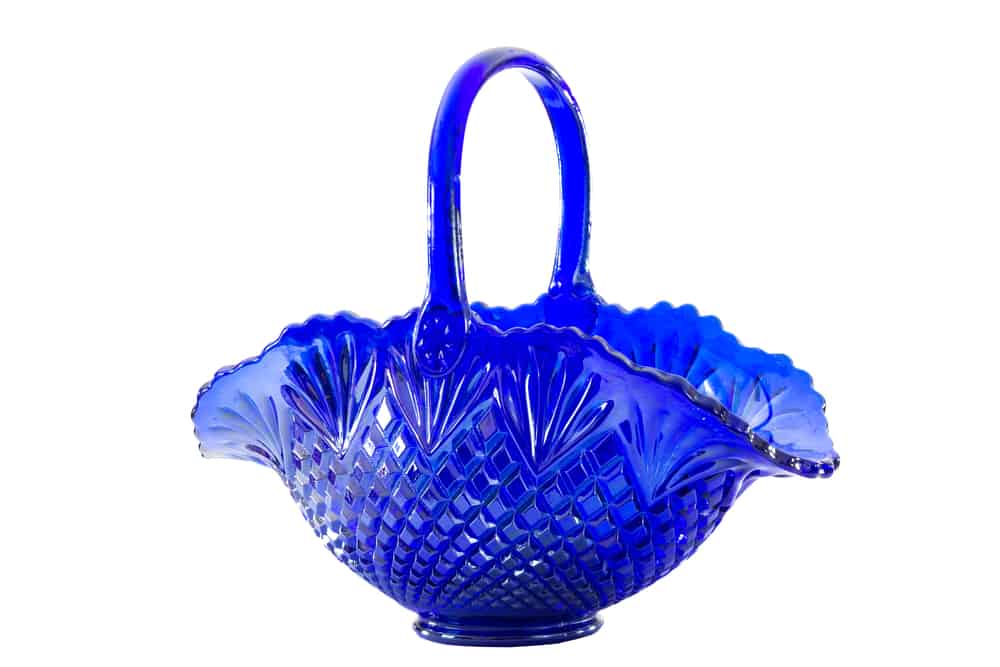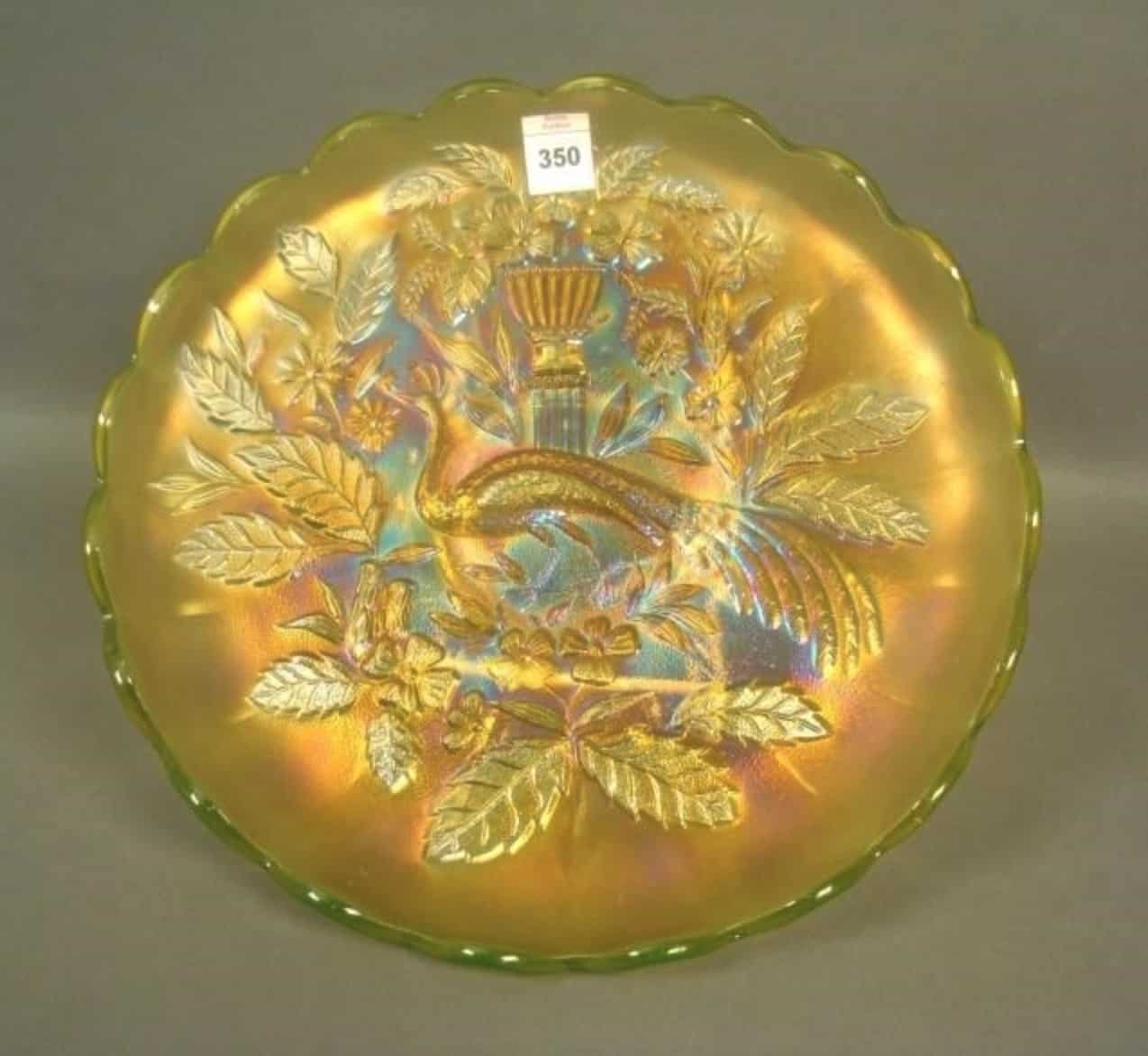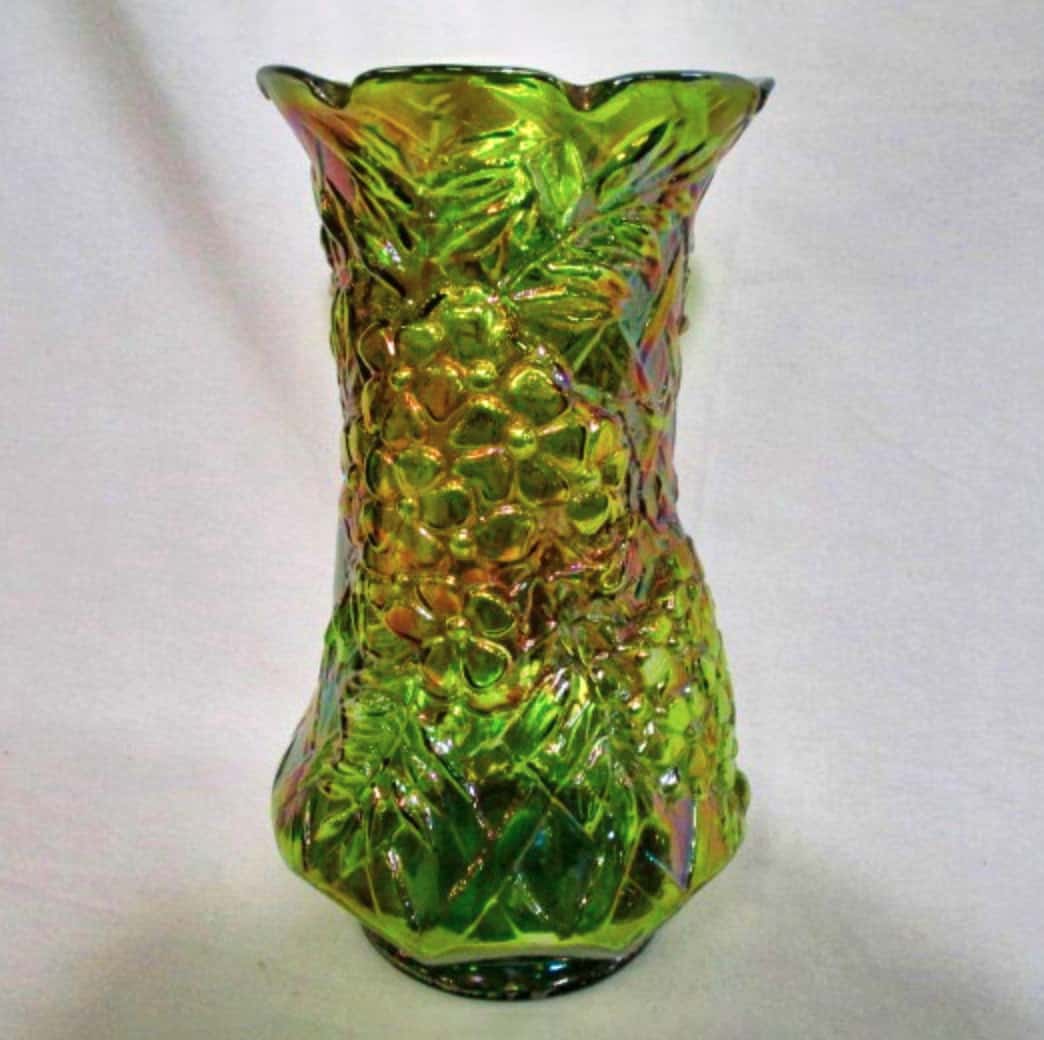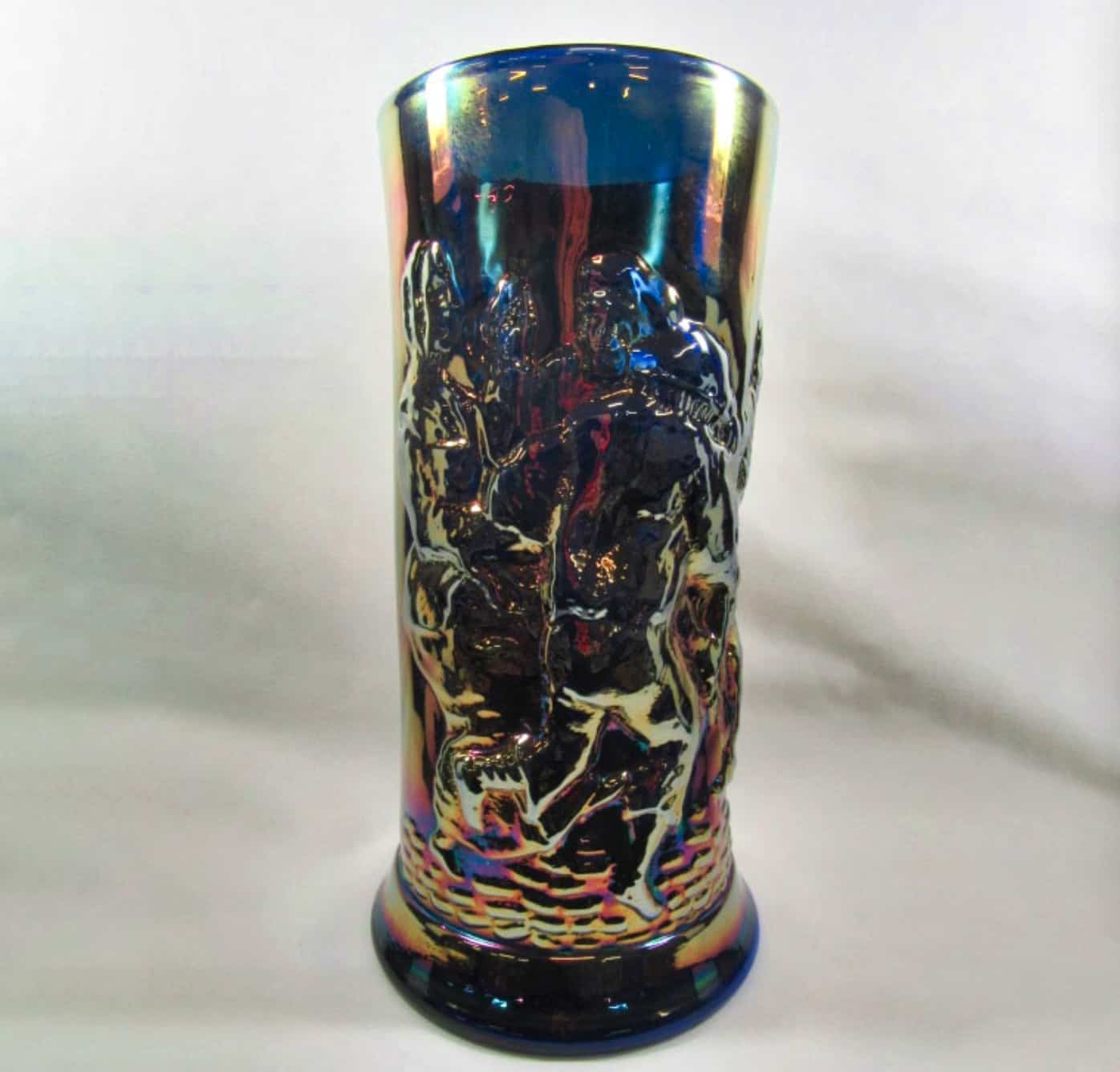Loved by many for its beautiful colors and unique designs, carnival glass is a highly collectible item and diverse piece of history that can fetch a high price at auction.
You can find carnival glass everywhere – from antique stores and yard sales to online auction sites and more. No doubt you have some already in your home, upstairs in your attic.
Mass-produced in the early 1900s, it’s only recently that collectors are taking a serious interest in how unique and striking this antique glass truly is. So, how can identify your carnival glass and tell if it’s trash or treasure?
Today we’re going to explain how you go about identifying your carnival glass, including what its color, size, shape, and branding can tell you.
Table of Contents
History of carnival glass
Firstly, let’s look at the history of carnival glass to see what makes it such a collectible antique.
Originally known as ‘iridill’ or ‘iridescent ware’, carnival glass has an interesting past. Made by the Fenton Art Glass Co. in 1907, highly patterned molds combined with sprayed metallic salts created striking, shimmering glass.
Originally, it imitated Tiffany Glass, which was very expensive. However, because Carnival glass was often cheap to buy, it was referred to as “a poor man’s Tiffany”.
It wasn’t long before other companies like Indiana Glass and Westmoreland, began developing carnival glass designs, and it became in high demand from the early 1900s to the 1920s.
Households across America liked carnival glass because it brightened homes at a time when only wealthy families had bright electric lighting. The colorful glass caught the light easily.
By 1925, carnival glass began to decline in popularity. Other styles and types, like depression glass, became the new trend.
It wasn’t until the 1950s, when many of these glass antiques were auctioned or given away as prizes at carnivals, that the nickname ‘carnival glass’ stuck. Collectors soon realized how diverse and varied these antique glass pieces were, making them highly collectible and their value began to soar.
A resurgence of interest in antique glassware, including carnival glass, has seen several companies reenter production.
How to identify carnival glass?
Carnival glass is very decorative and comes in many different shapes, sizes, and styles. If you’re serious about collecting this valuable glass, then the first thing you need to do is identify it.
However, there is one problem that you should be aware of. Companies that made carnival glass in the 1920s often changed their style and imitated their competitors. It can be difficult to know various manufacturers’ styles and dates of production.
That said, here are some useful ways you can still identify your piece:
Carnival Glass Shape
The first and easiest way of identifying your carnival glass is simply by looking at its shape!
Carnival glass was incredibly versatile and had many different uses around the home. These included:
- small food containers,
- cups, plates, and platters
- punch bowls, sugar bowls
- decorative centerpieces
- pitchers
- candlesticks,
- ashtrays
- vases
The next thing you should consider is how well the glass is. Carnival glass was made using molds – there should be an even layer of glass throughout the piece. A tell-tale sign of poor glass is if there’s uneven glass, usually at the bottom.
Carnival Glass Color
The signature look of carnival glass is undoubtedly its color. There are two colors you should be on the lookout for; the iridescent color and the base color.
Irisdensst color: every carnival glass has a signature ‘shimmer’ to its color. People often compare it to an ‘oil slick’ sheen, as when held up to the light, it should produce a rainbow glass effect.
Base color: otherwise known as the ‘underlying’ color of the glass. Because carnival glass was hand sprayed, the base is usually never covered in metallic salts, and its appearance will be different with every piece.
Popular base colors include:
- Marigold: Rich in vibrancy and tones, marigold carnival glass ranged from deep, dark oranges to pale peach. The base was usually left clear.
- Blue: Cobalt blue was a very popular color used across many types of pottery and glassware. Carnival glass was no exception, with tones ranging from ice blue, Persian blue (milky), and celeste blue (sky color).
- Amber: With a huge variety of shades, Amber had a signature, eye-catching ‘honey’ effect when hit by light.
Patterns
Competition within the carnival glass industry was intense! Companies such as Fenton, Northwood, and Imperial continuously developed new patterns, well into the 1930s.
And because companies changed styles and patterns so often, there’s no ‘distinct’ model that one brand follows consistently. So how can you identify a pattern?
Many collectors have begun cataloging carnival glass patterns. Over 2,000 have been recorded thus far. You can see a wide range of patterns here.
Don’t worry if you can’t spot exact matches to your pattern. If your antique carnival glass doesn’t look exactly like the photos – don’t panic! Photographs never quite capture the true colors or patterns of carnival glass.
Part of a set?
Because of their many uses around the home, and to try and make customers buy more glass, carnival glass manufacturers often produced complete, e.g. dining sets including serving dishes, plates, and cups, or bar sets with glasses and decanters.
As well as being grouped by purpose, glass was also made with distinctive designs to tie the collection together. One of the most recognizable sets of carnival glassware is the Fenton butterfly and Berry collection and the Northwood Grape and Cable bowls.
If you have more than one piece of carnival glass which forms part of a set, this can be very useful in identifying a brand or manufacturer and dating the pieces.
Does real carnival glass have seams?
Carnival glass pieces had intricate designs and decorations, purposefully there to hide any seams. Real carnival glass should not have any seams, or at the very least should be very well hidden.
How do you know if carnival glass is valuable?
Now that you’ve found out more about your carnival glass, it’s time to ask the all-important question – is it worth anything? There are some features to glassware that can affect its value. Let’s take a look:
Unique, hand-touches
Despite being machine pressed, glassmakers put finishing touches by hand. This means there can be small discrepancies between collections, which can add or deduct from their value. These include uneven sizing, spotty coloring, and different edging and crimping.
Color
Carnival glass has some of the most beautiful colors of all glassware. So what is the rarest color of carnival glass? Let’s take a quick look at some of the most expensive pieces sold:
- Yellow – a Peacock and Urn bowl sold for $66,000.
- Emerald green – a Northwood vase sold for $140,000.
- Blue – a Millersburg People’s vase sold for $155,000.
Intricate designs
If glass looks beautiful, it’s worth a lot. Some carnival glass patterns are very intricate and complicated, with incredible attention to detail. Matched with a strong iridescent shimmer, glass can fetch thousands at auction.
Take for example this Amethyst Kiwi piece from Australia. Although it is rather small and niche, it has beautiful edging, a strong shine, and a complex animal design – it is currently valued at over $9,995.
Condition
Especially if the carnival glass has been used, the condition of the glass and its color can affect its value. Common things can include:
- Being overwashed– the glass will have lost its original iridescent glaze.
- Wear-and-tear damage, including chips, scratches, and cracks.
- Uneven glass or different sizes could indicate a poor mold was used in production.
Origins
Carnival glass was produced around the world. And some collectors have a huge interest in collecting different styles from different countries. Some of the most popular international brands to keep an eye out for include:
- Brockwitz (Germany)
- Canning Town Glass (England)
- Inwald (Czechoslovakia)
- Crown crystal (Australia)
Differences between carnival glass and Depression glass?
One of the most common mistakes people make with carnival glass is mistaking it for depression glass, and vice versa.
Here’s a quick overview of the main differences between both types:
Dates
Carnival glass and depression glass dominated different periods.
- Carnival glass was hugely popular in the early 1900s. However, by the roaring 1920s, it dwindled in popularity.
- Depression glass, as its name implies, was mass-produced during the Great Depression between 1929 and 1939.
Color
Both carnival and depression glass varied in color. As we know, carnival glass had a bright, shimmery, rainbow effect to its glass. It had a multi-colored look and varied in color.
On the other hand, depression glass was more simple and translucent. It usually had a single color. Some types of depression glass, such as uranium glass, had incredibly striking colors.
Production
Carnival glass was sprayed and finished by hand. This led to many pieces having unique and distinctive finishing touches to the final product. On the other hand, depression glass was entirely machine-made and pieces were usually much more consistent.
Manufacturers
Although not many carnival or depression glass have maker’s marks, it’s worth noting that different manufacturers specialized in making carnival glass, and depression glass.
Popular carnival glass makers included: Fenton Art Glass Company, Northwood Glass Company, and the Dugan Glass Company.
Popular depression glass makers included: Hazel Atlas Glass Company, the Jeanette Glass Company, and the Federal Glass Company.



